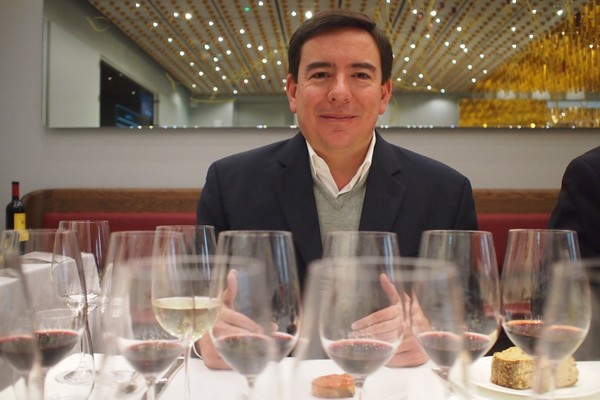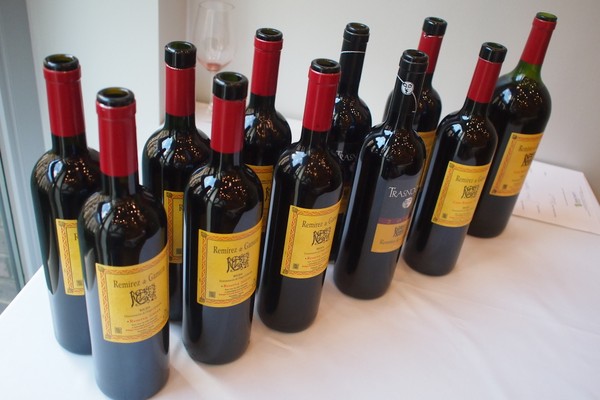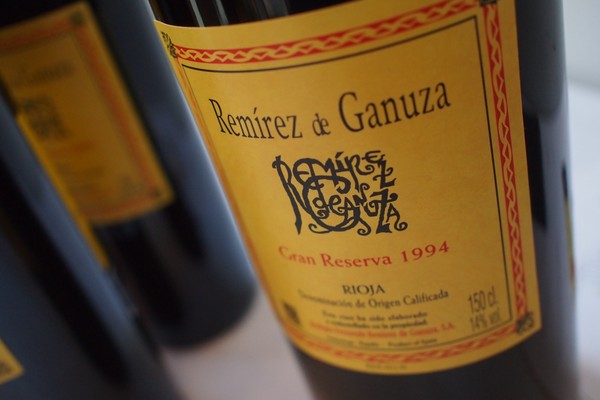|
Remírez de Ganuza
A vertical tasting of these high-end estate
Riojas

Luis Alberto
Martinez
There's
something a bit different about Remírez de Ganuza, a family owned
winery in Rioja. 'Rioja has been controlled by big wineries without
vineyards, ' says Luis Alberto-Martinez, who has been the winemaker
here for 8 years. [Aside: Luis is Mexican, raised in San Diego.] At
Remírez de Ganuza, there's an emphasis on the vineyards. They
started out in 1989 with 57 hectares of vines, but this has grown to
104 hectares spread across five villages. The average age of the
vines is 60 years. '40- 80 years old are the best years if they are
well kept,' says Luis. Vines over 90 are a bit like old people, he
says: some years you will get grapes, some years you won't. 'We have
made 2000 trades in Rioja of old vines,' he adds. They are based in
the Rioja Alavesa, the highest bit, with altitude of 500–610 metres.
It is protected to the north by the 1140 m Sierra de Cantabria; 18
000 of Rioja’s 62 000 hectares are in the Alavesa.

Remirez
de Ganuza have been testing organics and biodynamics to see if it
gives them an edge over their current sustainable practices. Luis
has a few doubts: 'is it a practice or a cult?' he asks. 'We try to
test everything we do, such as our barrels, our sorting table, and
our new system of pressing.' He says that other wineries take bits
of their philosophy when they've seen how they work.
‘Our
wines are not made in a traditional style,' says Luis. ‘We are
trying to respect our vines and make wines in a contemporary style.’
They were the first in the region to use small plastic picking
boxes. Picking is done by Portuguese people who have been working
here for 18 years, and they are paid by the hour and not volume: an
important part of their job is to do a selection in the vineyard.
Grapes that they discard are sold to others.
It's
considered too hot to pick between the hours of 11am and 5pm, and in
2005 they built a cold chamber for storing grapes. 10 people do hand
sorting in the winery , and a table was first employed in 1991,
which was the first experimental vintage. In 1992 15 000 bottles
were made; 1993 was a disastrous vintage; so the first serious
vintage was 1994.

On the
sorting table they do something remarkable: the tips of the bunches
are separated from the shoulders, something they first did in 1997.
The shoulders are considered to be better and are used for the Gran
Reserva. The tips are used to make young wine using carbonic
maceration, and there is less of the stem in the tip segment, so
this is better for making this wine. The shoulders, which compose
two-thirds of the bunch, are sent to the destemmer. 'There is a
small difference in the berries,' says Luis, 'and small details make
a big difference in the wine.
Once
fermentation has finished, the free run juice goes to the Reserva or
Gran Reserva, but the skins are still soaked with wine and this wine
is concentrated. This is where another innovative approach is taken.
Rather than take the skins out of the tank manually and put them in
the press, a process that involved oxygen exposure and friction,
they keep them in the tank, protected from oxygen. They inflate a
bag inside the tank with air, to get the shape of the tank, then
they fill it with water. The wine they recover using this process is
the most concentrated of all, and is called Trasnocho.
They
use new barrels, 85% French oak and 15% American. The wines stay 6
years in the winery before release. As well as the notes on these
wines below, you can also read about a
visit I made to the estate in
October 2009.
THE WINES
Remirez de Ganuza Reserva 2004 Rioja, Spain
Ripe, sweet, spicy, slightly tarry nose. Lush, rich, sweet and
powerful on the palate with ripe black fruits as well as earth and
spice, and a hint of mint. A bit grippy, and quite savoury in
character. 90/100
Remirez de Ganuza Reserva 2005 Rioja, Spain
Sweet, pure black fruits nose, with a sweet palate: ripe and
lush but very smoothly textured with attractive dark fruits and
fine, grainy structure. Lovely direct fruit here: pure, fine, with
some red fruits as well as black. 93/100
Remirez de Ganuza Reserva 2006 Rioja, Spain
Spicy, savoury, gravelly edge to the nose with complex herb and
tar notes. The palate is structured and complex with sweet black
fruits, herbs and spices. A warm autumnal wine with some
savouriness. Very stylish, even though this was a difficult harvest
with lots of heat during vintage. 94/100
Remirez de Ganuza Trasnocho 2007 Rioja, Spain
100% new French oak for 22 months. Powerful black fruits nose.
Concentrated, rich and sweetly fruited with some spiciness, too.
Dense and rich with grippy autumnal black fruits and integrated
spicy oak. 93/100
Remirez de Ganuza Gran Reserva 2005 Rioja, Spain
Sweet, lush, pure and lovely with black fruits dominant. Smootth-textured
and ripe with a hint of coffee and spice in the background.
Beautifully supple and pure. Approachable but serious at the same
time. 95/100
Remirez de Ganuza Gran Reserva 1994 Rioja, Spain (magnum)
Showing some evolution but developing beautifully. Hint of
bricking on the rim. Notes of herbs, earth and tea with lovely
elegant cherry and plum fruit as well as a silky, smooth texture.
Complex with notes of mint and herbs. Developing beautifully this is
a lovely wine. 96/100
Remirez de Ganuza Erre Punto Blanco 2011 Rioja, Spain
This is an inexpensive white wine; there’s also a partner Erre
Punto red. Lovely nose of herbs, fennel, ripe pear and citrus
fruits. The plate shows herbs, citrus, melon and is expressive and
precise, showing real finesse. 93/100
UK
agent: Bancroft Wines
See
also:
 Visiting
Rioja (series) Visiting
Rioja (series)
Wines
tasted 11/13
Find these wines with wine-searcher.com
Back
to top
|

